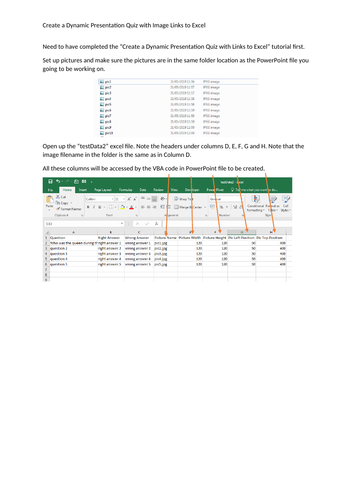










Instructions on how to create a powerful, dynamic presentation with Links and Images from Excel. Purpose of this is that the data can be changed in the excel file which subsequently updates the word art boxes and shapes in PowerPoint and keep track of how users are doing with various aspects of any test given.
Instructions and code have many useful features which empowers the end user to create a powerful Programming tool which demonstrates a high skill set over multiple applications.
VBA coding shows the following:
- access an excel file
- write to an excel file
- get contents from an excel cell onto a WordArt object in Powerpoint
- enable shapes to act as buttons
- create functions
- create and use subroutines
- create a global variable and use that value to write to a file
- duplicate slides
- hide and unhide components
- change colour and position of components
- add images to presentation dynamically
Fulfills a number of Computing KS3 and KS4 elements such as:
*undertake creative projects that involve selecting, using, and combining multiple applications, preferably across a range of devices, to achieve challenging goals, including collecting and analysing data and meeting the needs of known users
*create, re-use, revise and re-purpose digital artefacts for a given audience, with attention to trustworthiness, design and usability
*undertake creative projects that involve selecting, using, and combining multiple applications, preferably across a range of devices, to achieve challenging goals, including collecting and analysing data and meeting the needs of known users
*use two or more programming languages, at least one of which is textual, to solve a variety of computational problems; make appropriate use of data structures [for example, lists, tables or arrays]; design and develop modular programs that use procedures or functions.
Something went wrong, please try again later.
This resource hasn't been reviewed yet
To ensure quality for our reviews, only customers who have purchased this resource can review it
Report this resourceto let us know if it violates our terms and conditions.
Our customer service team will review your report and will be in touch.
